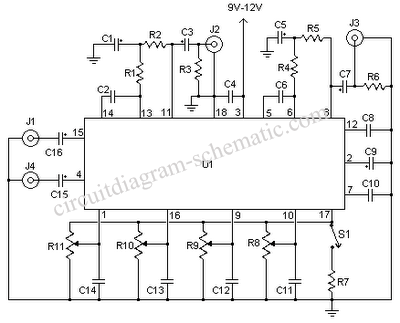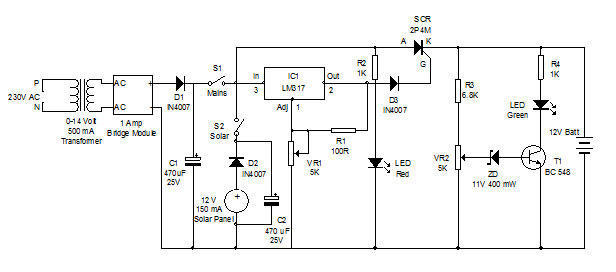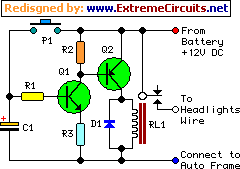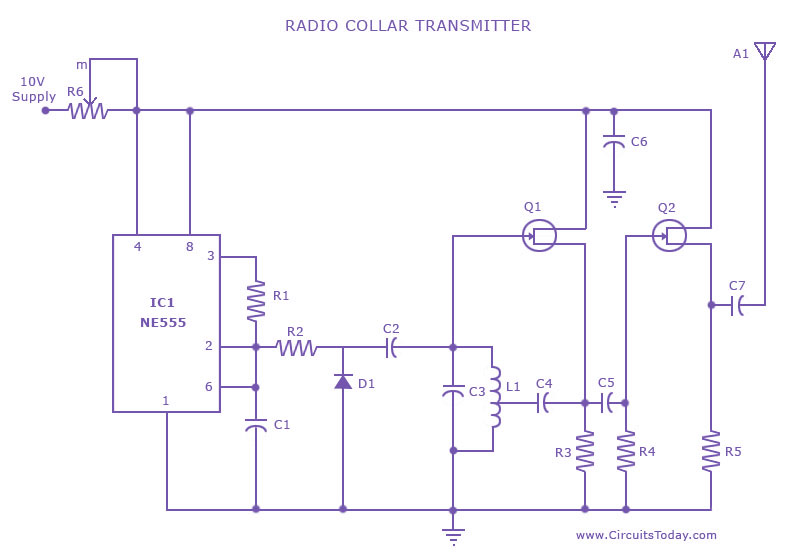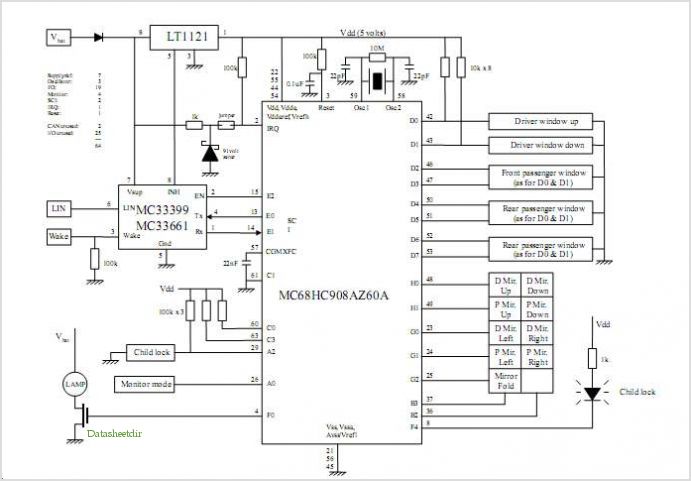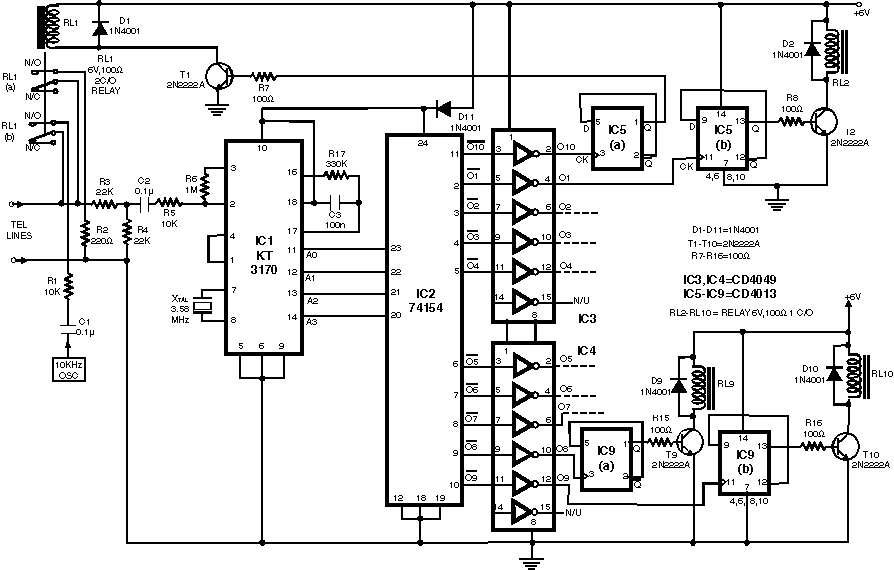
Flip-Flop Timer Using 4017
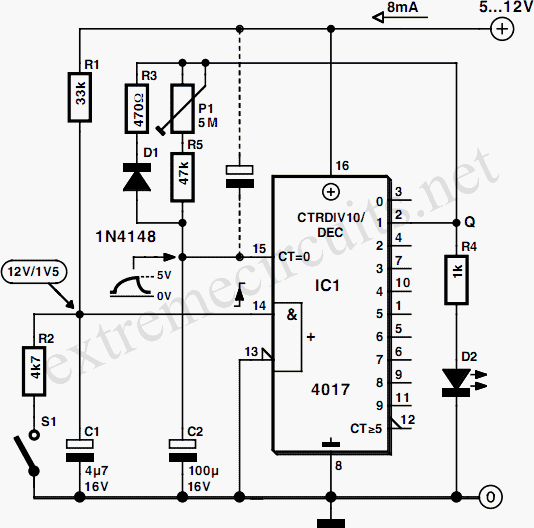
This circuit demonstrates the application of a 4017 CMOS decade counter to construct a timer circuit. The push-button switch S1 discharges capacitor C1 through resistor R2. Upon releasing S1, capacitor C1 charges through resistor R1, generating a rising edge at the clock input of IC1. This transition causes the output Q1 to go high, reaching the supply voltage. Current then flows through resistor R4 and LED D2, illuminating the LED. Concurrently, capacitor C2 begins to charge through preset resistor P1 and resistor R6. When the voltage across C2 approaches approximately half of the supply voltage, it resets IC1, bringing Q1 low and turning off the LED. Capacitor C2 then discharges through diode D1 and resistor R3. The circuit remains in this stable reset state until S1 is pressed again. The preset resistor P1 allows for adjustment of the ON time, ranging from 5 seconds to 7 minutes. In its reset state, the circuit consumes only a few microamps, while the current rises to about 8mA when S1 is pressed, primarily due to the LED current. When power is initially applied to the circuit, IC1 may enter an indeterminate state, potentially causing the LED to be on. Pressing S1 until the LED turns off resolves this condition. Alternatively, capacitor C2 can be connected to the supply rail (as indicated by the dotted line in the diagram) to ensure that IC1 powers up in a reset state. However, this configuration has a disadvantage, as any noise on the supply rail could couple to the reset pin of IC1, potentially affecting the timing period.
The circuit utilizes the 4017 CMOS decade counter, which is a versatile component often employed in timing and counting applications. The operation begins with the press of switch S1, which initiates the discharge of capacitor C1 through resistor R2. This action sets the stage for a clock pulse to be generated when S1 is released, allowing C1 to charge through R1, thereby creating a rising edge at the clock input of the IC.
The output Q1 of the 4017 will transition high, activating the LED D2 via resistor R4. The simultaneous charging of capacitor C2 through preset resistor P1 and resistor R6 is crucial, as it sets the timing interval for the circuit. The design allows for an adjustable timing range, which can be fine-tuned by varying the value of P1. The timing mechanism is based on the voltage threshold of C2, where reaching approximately half the supply voltage triggers a reset of the IC.
Upon reset, the output Q1 goes low, turning off LED D2, and capacitor C2 discharges through diode D1 and resistor R3, returning the circuit to its initial stable state. This cycle continues with the pressing of S1, providing a simple yet effective timer functionality.
The current consumption characteristics of the circuit are noteworthy, as it operates at minimal power in the reset state, making it suitable for battery-powered applications. The increase in current draw during the active state is primarily due to the LED, which serves as a visual indicator of the timer's operation.
It is also important to consider the alternative configuration for capacitor C2, which connects it to the supply rail. This modification ensures that the IC starts in a reset state upon power-up, mitigating any issues related to indeterminate states. However, this approach introduces the potential for noise from the supply rail to influence the reset pin, which may inadvertently affect the timing accuracy of the circuit. Thus, careful consideration of the circuit's environment and power supply stability is essential for optimal performance.This circuit shows how a 4017 CMOS decade counter can be used to build a timer circuit. Push-button S1 will discharge capacitor C1 through resistor R2. When S1 is released, C1 will charge up through R1 causing a rising edge at the clock input of IC1. This causes the output Q1 to go high (to the supply voltage). Current will‚ow through R4 and LE D D2 will light. At the same time C2 will begin charging through preset P1 and R6. When the voltage on C2 reaches approximately half the supply voltage it will reset IC1. Q1 will go low, the LED will go off and C2 will discharge through D1 and R3. The circuit will now remain stable in this reset condition until S1 is pressed again. Preset P1 allows the ON time of the circuit to be adjusted between 5 seconds and 7 minutes. The current consumption of this circuit in its reset state is only a few micro-amps, rising to approximately 8mA mainly due to the LED current, when S1 is pressed. When power is applied to the circuit IC1, can be in an indeterminate state and the LED may be on. Pressing S1 until the LED goes off clears this condition. Alternatively C2 may be connected to the supply rail (as shown dotted in the diagram) this will ensure that IC1 will always power up in a reset state.
A disadvantage of this conguration is that any noise on the supply rail will be coupled through to the reset pin of IC1 and may affect the timing period. 🔗 External reference
The circuit utilizes the 4017 CMOS decade counter, which is a versatile component often employed in timing and counting applications. The operation begins with the press of switch S1, which initiates the discharge of capacitor C1 through resistor R2. This action sets the stage for a clock pulse to be generated when S1 is released, allowing C1 to charge through R1, thereby creating a rising edge at the clock input of the IC.
The output Q1 of the 4017 will transition high, activating the LED D2 via resistor R4. The simultaneous charging of capacitor C2 through preset resistor P1 and resistor R6 is crucial, as it sets the timing interval for the circuit. The design allows for an adjustable timing range, which can be fine-tuned by varying the value of P1. The timing mechanism is based on the voltage threshold of C2, where reaching approximately half the supply voltage triggers a reset of the IC.
Upon reset, the output Q1 goes low, turning off LED D2, and capacitor C2 discharges through diode D1 and resistor R3, returning the circuit to its initial stable state. This cycle continues with the pressing of S1, providing a simple yet effective timer functionality.
The current consumption characteristics of the circuit are noteworthy, as it operates at minimal power in the reset state, making it suitable for battery-powered applications. The increase in current draw during the active state is primarily due to the LED, which serves as a visual indicator of the timer's operation.
It is also important to consider the alternative configuration for capacitor C2, which connects it to the supply rail. This modification ensures that the IC starts in a reset state upon power-up, mitigating any issues related to indeterminate states. However, this approach introduces the potential for noise from the supply rail to influence the reset pin, which may inadvertently affect the timing accuracy of the circuit. Thus, careful consideration of the circuit's environment and power supply stability is essential for optimal performance.This circuit shows how a 4017 CMOS decade counter can be used to build a timer circuit. Push-button S1 will discharge capacitor C1 through resistor R2. When S1 is released, C1 will charge up through R1 causing a rising edge at the clock input of IC1. This causes the output Q1 to go high (to the supply voltage). Current will‚ow through R4 and LE D D2 will light. At the same time C2 will begin charging through preset P1 and R6. When the voltage on C2 reaches approximately half the supply voltage it will reset IC1. Q1 will go low, the LED will go off and C2 will discharge through D1 and R3. The circuit will now remain stable in this reset condition until S1 is pressed again. Preset P1 allows the ON time of the circuit to be adjusted between 5 seconds and 7 minutes. The current consumption of this circuit in its reset state is only a few micro-amps, rising to approximately 8mA mainly due to the LED current, when S1 is pressed. When power is applied to the circuit IC1, can be in an indeterminate state and the LED may be on. Pressing S1 until the LED goes off clears this condition. Alternatively C2 may be connected to the supply rail (as shown dotted in the diagram) this will ensure that IC1 will always power up in a reset state.
A disadvantage of this conguration is that any noise on the supply rail will be coupled through to the reset pin of IC1 and may affect the timing period. 🔗 External reference
Warning: include(partials/cookie-banner.php): Failed to open stream: Permission denied in /var/www/html/nextgr/view-circuit.php on line 713
Warning: include(): Failed opening 'partials/cookie-banner.php' for inclusion (include_path='.:/usr/share/php') in /var/www/html/nextgr/view-circuit.php on line 713
